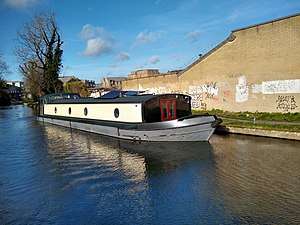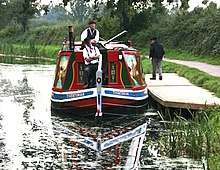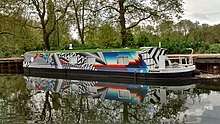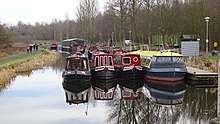Widebeam
A widebeam is a canal boat built in the style of a British narrowboat but with a beam of 2.16 metres (7 ft 1 in) or greater. Widebeams are found on the UK waterways, a canal and river system that is managed by the Canal and River Trust (CRT) [1][2]

The nature of a widebeam
The CRT[3] gives no precise definition of a "widebeam", merely distinguishing it from other types of canal craft such as: narrowboats, Thames sailing barges, Dutch barges, other barge types, grp cabin cruisers, and wooden boats.[2] Nevertheless, the salient features of a modern widebeam are:
A widebeam is built in the style of a cruising narrowboat, that is to say, a steel-hulled barge used mainly by leisure boaters. [4] Typically, this entails a bow well-deck with doors leading aft to the living accommodation. The long saloon typically has numerous side-windows, and while its coachroof may have fitments such as solar panels and skylights, the overall height (as with a narrowboat) must be low enough to negotiate canal bridges. Echoing narrowboats, a widebeam's stern may be a cruiser stern or a "semi-trad"; but these days it is rare to see a widebeam with a traditional stern.[5][6] Unlike some traditional narrowboats, a modern widebeam will rarely have a walk-through engine room with an antique engine such as a Bolinder; its engine will normally be found beneath the stern deck.
Whereas (except at the bow and stern) a narrowboat will normally have a rectangular cross-section below the gunwales, (although narrowboats with V-shaped bilge sections are not unknown), many widebeams may have a chined cross-section. A chined hull may steer more predictably than a flat-bottomed barge, because it holds a course more readily; and the chine allows the widebeam to approach closer to the canal bank where the canal is shallow.
History

When English canals were first built to assist transport during the Industrial Revolution, locks were only 2.1 metres (7 ft) wide. Most narrow locks are 21.9 m (72 ft) long, but some are only 17.7 m (58 ft).[5] It was soon realised that it would be more efficient to have wider canals with wider 4.3 m (14 ft) locks, and widebeam boats were introduced to take advantage of this change. Of course, the wider locks also meant that two narrowboats could enter a lock side-by-side, which was particularly useful if the second boat was a towed "butty".[7][8][9]
While a 17.4 m (57 ft) long narrowboat may travel the entire UK waterways, there is still no wide link between the north and the south of England, so widebeams must stay in one part or the other unless they are prepared to make the journey in the sea around the coat, a journey for which most widebeams are unsuited. (Occasionally narrowboats take to the sea, such as Terry Darlington's "Phyllis May", but both narrowboats and widebeams are Class D vessels fit for rivers,[10] small lakes and canals. Inevitably, their greater beam makes widebeams more stable than narrowboats, but, with their bow welldeck vulnerable to flooding, they are still not true seagoing boats.[11]
There is a plan to make a north-south link around Bedford, but this may take decades to accomplish.[12]
Dimensions


A widebeam has beam of 2.16 metres (7 ft 1 in) or more.[13][14] Any widebeam with a permanent mooring and which is used a houseboat may be almost any size; but a widebeam intending to cruise the waterways must comply with size restrictions which dependant upon the dimensions of the waterway. A cruising widebeam's LOA is limited by the length of the shortest lock, its beam by the width of the narrowest lock (or some other width restrictions), and its draft by the canal's depth. (A canal is shallower at the sides than in the centre). Compared to narrowboats, this is a significant disadvantage for widebeams, particularly when meeting other boats.[5]). A further restriction is that, if a cruising widebeam is to negotiate bridges and tunnels, its air draft must allow adequate clearance.
Dimensional restrictions on widebeams in and around London
In the East of London, if cruising only the Lee Navigation from Hertford to Limehouse Basin, a widebeam's maximum dimensions (length, beam, draft, and height, respectively) are 25.8 metres (84 ft 8 in), 4.7 metres (15 ft 5 in), 1.6 metres (5 ft 3 in), 2.18 metres (7 ft 2 in).
A widebeam that navigates through central London on the Regents Canal to Little Venice, is further restricted: its length, beam, and draft must not exceed 22.36 metres (73 ft 4 in), 4.22 metres (13 ft 10 in), 1.28 metres (4 ft 2 in). The height restriction of a boat on the Lee (due to low bridges) means that a boat that can cruise on the Lee Navigation is low enough to cruise on Regents Canal.
The section of the Paddington Arm of the Grand Union Canal to the junction of the main Grand Union has a further height restriction of 2.08 metres (6 ft 10 in).[15]
At the junction of the Paddington Arm and the main Grand Union Canal, if the boat were to turn south through Brentford and navigate the Thames to Limehouse Basin, its maximum length is further restricted to 22.2 metres (72 ft 10 in). If the boat were to turn north and travel to Rickmansworth, its maximum length must not exceed 21.75 metres (71 ft 4 in).
From Rickmansworth, a boat may travel north up the Grand Union, but at Leighton Buzzard there is a lock that is only 3.81 metres (12 ft 6 in) wide, so any boat with a beam of 4.22 metres (13 ft 10 in) able to navigate canals and rivers in and around London will be unable able to proceed further north.
Any widebeam built for navigating on the Grand Union (south of Leighton Buzzard), the Regents Canal and the Lee Navigation will be unable to travel up the river Stort (a tributary of the Lea), unless its maximum dimensions do not exceed a length, beam, depth and height (respectively) of 21.75 metres (71 ft 4 in), 4.08 metres (13 ft 5 in), 1.03 metres (3 ft 5 in), 2.05 metres (6 ft 9 in).
| Waterway | Length | Beam | Depth | Height |
|---|---|---|---|---|
| Grand Union Canal (GUC)—Paddington Arm[17] | 4.3 metres (14 ft 1 in) | 2.08 metres (6 ft 10 in) | ||
| Grand Union Canal—Brentford to Bulls Bridge[18] | 22.2 metres (72 ft 10 in) | 4.26 metres (14 ft 0 in) | 1.48 metres (4 ft 10 in) | 2.88 metres (9 ft 5 in) |
| Grand Union Canal—Bulls Bridge to Rickmansworth[19] | 21.75 metres (71 ft 4 in) | 4.26 metres (14 ft 0 in) | 1.03 metres (3 ft 5 in) | 2.34 metres (7 ft 8 in) |
| Lee Navigation[18] | 25.8 metres (84 ft 8 in) | 4.7 metres (15 ft 5 in) | 1.6 metres (5 ft 3 in) | 2.18 metres (7 ft 2 in) |
| Regents Canal[18] | 22.36 metres (73 ft 4 in) | 4.22 metres (13 ft 10 in) | 1.28 metres (4 ft 2 in) | 2.64 metres (8 ft 8 in) |
| Maximum size for unimpeded navigation of the above waterways | 21.75 metres (71 ft 4 in) | 4.22 metres (13 ft 10 in) | 1.03 metres (3 ft 5 in) | 2.08 metres (6 ft 10 in) |
| River Stort[18] | 26.8 metres (87 ft 11 in) | 4.08 metres (13 ft 5 in) | 2.05 metres (6 ft 9 in) | |
| Maximum size for unimpeded navigation of all the waterways listed here | 21.75 metres (71 ft 4 in) | 4.08 metres (13 ft 5 in) | 1.03 metres (3 ft 5 in) | 2.05 metres (6 ft 9 in) |
Notes
- The Canal and River Trust (CRT) gives more than one minimum width for a wide beam on their website: "anything wider than [2.1 metres (7 ft)]" in Wide beam, wider considerations (Canal & River Trust 2019a) and "[A narrowboat is] up to a maximum of 2.2m wide ... [and a widebeam is] up to double the width of a narrowboat or even wider on larger rivers" All craft great and small (Canal & River Trust 2019b). However in April 2020 the CRT started to issue licences that charge more for any canal boat that has a beam of 2.16 metres (7 ft 1 in) or greater, (CRT licence 2019) and is now the de facto definition for the minimum width of a widebeam.
- Canal & River Trust 2019b.
- In Canal & River Trust 2019b
- Canal & River Trust 2019b.
- Canal & River Trust 2019a.
- The CRT gives a picture is of a boat wider than a narrowboat, but built in the style of a narrowboat.Canal & River Trust 2019a
- "Narrow Boat" 1944 LTC Rolt
- Clew, Kenneth R. (1968). The Kennet & Avon Canal. p.
- "Landscape with Canals" 1977 LTC Rolt
- Ita Yachts Canada 2014.
- Standard narrowboats and widebeams have engines with sufficient power to move the vessel in calm water; any canal boat wishing to take to the sea, or a fast-flowing river, or a tidal estuary (such as the River Severn), should have an engine with considerably more power than usual.
- "Imray's Map of the Inland Waterways of Great Britain" showing the proposed north-south link.
- CRT licence 2019.
- In April 2020 two additional pricing bands were be introduced by the CRT for boat widths over 2.16 to 3.24 metres (7 ft 1 in to 10 ft 7 1⁄2 in) and those over 3.24 metres (10 ft 7 1⁄2 in)—CRT licence 2019. This applies to both widebeams and other types of boats, and the CRT has not split widebeams into two new named groups based on width.
- Note: The Paddington Arm has no locks, so the width restriction is due to some other impediment.
- This list is for demonstration of how navigational restrictions affect the dimensions of widebeams and is not extensive. It does not include rivers like River Roding (not managed by the CRT), or some minor canals and rivers like the Hertford Union Canal and Bow Back Rivers
- No locks (Canal & River Trust 2020)
- Canal & River Trust 2020.
- To Stockers Lock—number 82 (Canal & River Trust 2020)
References
- "Wide beam, wider considerations". Canal & River Trust. 31 January 2019a. Retrieved 20 January 2020.
- "All craft great and small". Canal & River Trust. 28 January 2019b. Retrieved 20 January 2020.
- "Boat licence fees for 2019-2020". Canal & River Trust. 2019. Retrieved 20 January 2020.
- "Waterway dimensions" (PDF). Canal & River Trust. January 2020. Retrieved 20 January 2020.
- "Demystifying yacht classification A, B, C, D". Ita Yachts Canada. 20 March 2014. Retrieved 18 May 2020.